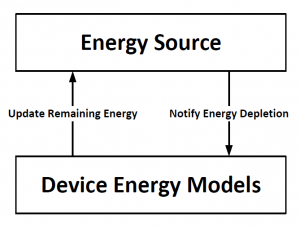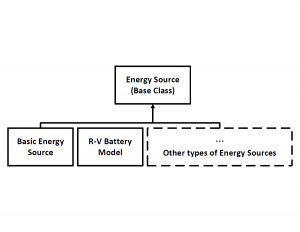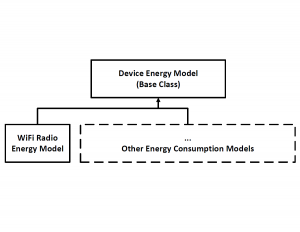Difference between revisions of "Energy model"
(→Usage) |
|||
| Line 1: | Line 1: | ||
= Background = | = Background = | ||
| − | Energy modeling is a key element in wireless network simulation. | + | Energy modeling is a key element in wireless network simulation. In several simulation scenarios, the energy consumption at a particular node, or at a particular component of a node, is of interest. Further, energy consumption is an important metric for evaluating the performance of wireless network protocols. Also, if a protocol is energy-aware, i.e. its operation depends on the energy level, it cannot be effectively simulated without an energy model. An energy model has been implemented in ns2 ([http://www.isi.edu/nsnam/ns/doc/node224.html ns2 energy model]) but is yet to be implemented in ns3. |
= Project Goals = | = Project Goals = | ||
| − | + | In this project, we aim to provide the basic structures for modeling energy sources and energy consumption of various devices on the node. The energy source class will enable the modeling of batteries, discharging models, etc. while the energy consumption models are used to represent the energy consumed by various components of a node. The energy model will provide the following components: | |
*Energy source model. | *Energy source model. | ||
**Battery. | **Battery. | ||
**etc. | **etc. | ||
| − | *Device energy model. | + | *Device energy consumption model. |
**Radio. | **Radio. | ||
**etc. | **etc. | ||
Revision as of 06:18, 21 April 2010
Contents
Background
Energy modeling is a key element in wireless network simulation. In several simulation scenarios, the energy consumption at a particular node, or at a particular component of a node, is of interest. Further, energy consumption is an important metric for evaluating the performance of wireless network protocols. Also, if a protocol is energy-aware, i.e. its operation depends on the energy level, it cannot be effectively simulated without an energy model. An energy model has been implemented in ns2 (ns2 energy model) but is yet to be implemented in ns3.
Project Goals
In this project, we aim to provide the basic structures for modeling energy sources and energy consumption of various devices on the node. The energy source class will enable the modeling of batteries, discharging models, etc. while the energy consumption models are used to represent the energy consumed by various components of a node. The energy model will provide the following components:
- Energy source model.
- Battery.
- etc.
- Device energy consumption model.
- Radio.
- etc.
Energy Model Hierarchy
The energy model consists of 2 major components:
- Energy source.
- Device energy model.
Only a single energy source will exist on a node, representing the total energy reserve at the node. Multiple device energy model can exist on a single node, representing different devices. The device energy model will update the remaining energy at the energy source. When energy is depleted, the energy source will notify all device energy models.
Energy Source
Child of the energy source class implements a specific type of energy source, eg. a battery. This base class provides interfaces for different energy model to update/record total energy consumption on the node. Some typical child classes:
- Basic energy source.
- Provides basic energy source functionalities such as keeping track of remaining energy, decrease remaining energy, notify device energy models for energy depletion.
- Battery energy source.
- Sub class that models behavior of a battery.
Device Energy Model
Child of the device energy model class implements energy consumption schemes of a specific device, eg. a radio device. This class provides interfaces for updating remaining energy in the energy source and handles notifications form the energy source when node energy is depleted. It can also records the total energy consumption of the device. Note that multiple device energy model can exist on the same node.
A typical child implementation of this class is the radio energy model class.
Radio Energy Model
This class represents energy model for radio devices. It is a base class for implementing other radio energy models. The radio energy model defines the typical operating states of a radio:
- Idle
- Tx
- Rx
- Sleep
Behaviors of switching between different modes are implemented by radio energy model's child class. Note that multiple radio energy model can exist on the same node.
Usage
Coming soon.
Schedule
- 4/19/2010 - 4/23/2010: Private review of radio energy model.


